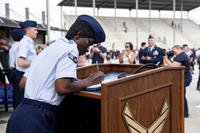The lessons learned from the airstrike on the Doctors Without Borders hospital in Afghanistan have reverberated through U.S. Central Command and led pilots to pay even closer attention to the already strict rules of engagement, the top general for the Iraq-Syria air war said Thursday.
The bottom line was that "if you have any doubt, don't drop" to avoid civilian casualties, Air Force Lt. Gen. Charles Q. Brown Jr., commander of U.S. Air Forces Central Command, said in a video briefing from the Mideast to the Pentagon.
Brown also echoed concerns voiced earlier by Air Force Chief of Staff Mark Welsh about a potential shortage of precision-guided bombs for the air war against the Islamic State of Iraq and Syria (ISIS). Since the air campaign began in August 2014, about 38,000 munitions have been dropped or fired in Iraq and Syria, according to Air Force statistics.
"It's still a concern, we have to balance that," as the air campaign accelerates in the effort to assist local forces in retaking Mosul in Iraq and Raqqa, the main ISIS stronghold in Syria, Brown said.
The Air Force was moving to buy more precision-guided munitions, but "those weapons are about two years away," Brown said. "The other piece is we have stocks around the world" for use by other combatant commands, but "we have to do some analysis before we take risks," he said.
"What I mean by that is -- where do we pull weapons from and do we use them now or save them for later? It's something we pay close attention to," Brown said.
The use of GPS-guided weapons and close coordination between aircrews and the Combined Air Operations Center at Al Udeid airbase in Qatar has led to what Brown called the "most precise air campaign in history, but those methods and procedures failed in the attack last October by an AC-130 gunship on a Doctors Without Borders Hospital in the provincial capital of Kunduz, Afghanistan, that killed at least 42.
In releasing a 3,000-page CentCom report on the incident last month, Army Gen. Joseph Votel, the CentCom commander, said, "The comprehensive investigation concluded that this tragic incident was caused by a combination of human errors, compounded by process and equipment failures."
"They were trying to do the right thing," Votel said of the U.S. Special Forces on the ground who called in the strike and the gunship crew, but a combination of errors resulted in their unleashing a 30-minute rain of cannon and gatling gun fire on the wrong target.
Referring to the hospital strike, Brown said that "the real takeaway from something like that as it applies to us here" was to "make sure we are going with the rules of engagement," and to focus on "communications of all elements" involved in a mission. "We spend a lot of time talking about it," Brown said, and "if they have any doubt, they do not drop."
Earlier this month, Defense Secretary Ashton Carter ordered the military to teach the lessons learned from Kunduz to all units before they deploy, with an emphasis on what to do when their technology breaks down.
"I am committed to ensuring that similar incidents do not occur in the future," Carter said in a memo to the service secretaries and combatant commanders.
Carter called on leaders to "incorporate the Kunduz scenario into pre-deployment training as an example of the complex environment into which units are deploying." He also ordered them to "establish a standard operating procedure to address contingencies when systems fail."
-- Richard Sisk can be reached at richard.sisk@military.com.




























